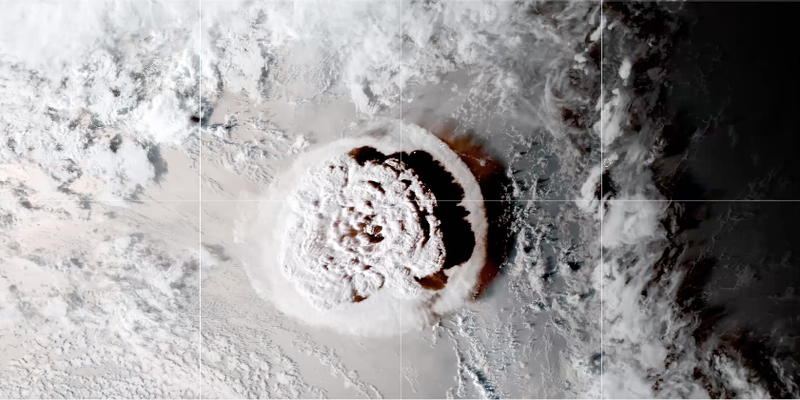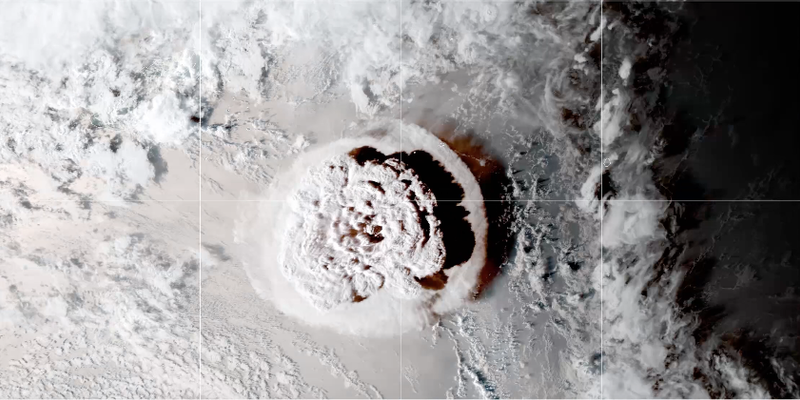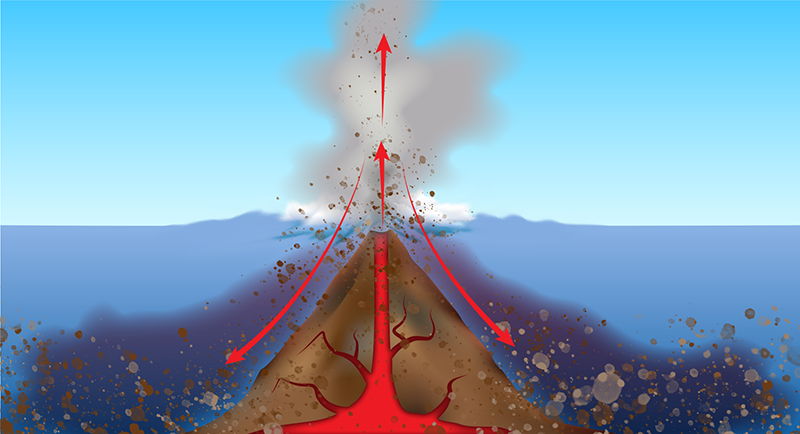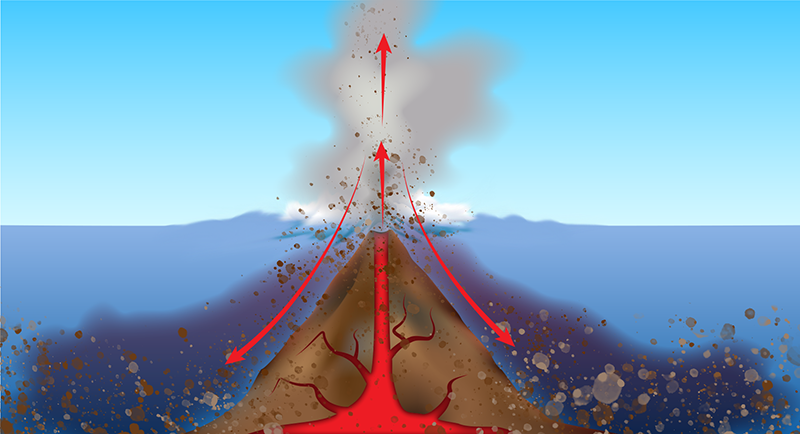Breakneck Outflows from Earth’s Most Explosive Eruption
On January 15, 2022, Earth experienced its most explosive volcanic eruption in 140 years at Hunga Tonga–Hunga Haʻapai, a partially submerged volcano in the Pacific Ocean near the Kingdom of Tonga’s main island. Now Michael Clare and Isobel Yeo of the UK’s National Oceanography Centre and their colleagues have determined the maximum speed of the underwater rock flows associated with this event [1]. Their study constitutes the most detailed investigation into the underwater aftermath of a powerful volcanic eruption and opens a new window onto a broad class of particle-laden flows.
The eruption at Hunga Tonga–Hunga Haʻapai hurled more than 6 km3 of debris up to a height of 57 km. When that ejecta plunged back to Earth, some of it struck the volcano’s steep underwater slopes, launching torrents of water-entrained sediment outward across the seafloor. Seven minutes after the initial eruption, Tonga lost its internet connection to the rest of the world, an event that Clare, Yeo, and their colleagues used to deduce the speed at which the entrained material moved.
This “breaking-of-a-seafloor cable” method for determining material flow speeds made its debut in 1929. A large earthquake triggered an underwater landslide off the coast of Newfoundland, Canada, that sequentially broke all the telegraph cables that connected the US to Europe at that time. Then in 1979, the method was again used when, during its construction, an extension to Nice Côte d’Azur Airport, France, collapsed into the Mediterranean Sea. The speed of the Newfoundland and Nice flows, and others measured in the same way since, were significantly lower than Hunga’s, which was both fast and extensive: when the research team surveyed the seafloor after the eruption, they found newly deposited material as far as 100 km from the volcano. This material came from the 3 km3 of sediment that the flows cut and scoured in the immediate vicinity of the volcano. Such was the volume of removed material, some sections of Tonga’s internet cable were left buried under 22 m of rubble.
The material zooming down Hunga’s slopes and across the seafloor moved in what resembled a pyroclastic density current (PDC). Observed on land, PDCs arise when hot ejecta—rock, ash, and gas—lose their buoyancy and flow down a slope under gravity. Clare stresses that the flows at Hunga are different from PDCs in that they were created when large fluxes of erupted, dense volcanic material collapsed vertically into the sea. This inception mechanism—direct entry of pyroclastic material into the ocean—was previously undocumented, Yeo says, which explains the novelty of observing such remarkable flow speeds.
The documentation of this new inception mechanism is a key outcome of the study, says Michael Manga of the University of California, Berkeley, who spent this past winter studying submarine volcanism in the Aegean Sea. “[The study] shows that the eruption column collapsed to feed submarine flows, that these flows travelled fast and a long way, and that we have estimates of the volume that erupted,” he says.
Besides encompassing wide ranges of temperature and composition, density currents such as those at Hunga are also turbulent and exchange energy and momentum with the surrounding fluid and the underlying surface. What’s more, the currents can transition from extremely dense flows of granular particles to dilute discharges of fully turbulent suspensions. Flow phases can coexist and change over time. Thus, the team says, the findings add to the understanding of the diversity and complexity of the particulate flows, which include some of the largest floods, avalanches, and gravity currents on the planet. That information is key for improving predictions of the impacts of major environmental hazards on infrastructure and society.
Although the 2022 Hunga eruption was unusually violent, it was among the 80% or so eruptions whose consequences play out partially or wholly underwater. Some new undersea cables will inevitably cross volcanically active regions. Yeo says that the new results from the research team indicate the need to identify submerged volcanoes that could threaten such cables and, more broadly, to start monitoring these underrecognized hazards.
–Charles Day
Charles Day is a Senior Editor for Physics Magazine.
References
- M. A. Clare et al., “Fast and destructive density currents created by ocean-entering volcanic eruptions,” Science 381, 1085 (2023), https://www.science.org/doi/abs/10.1126/science.adi3038.







